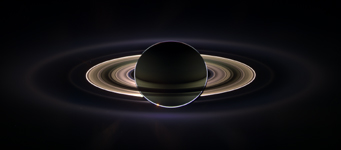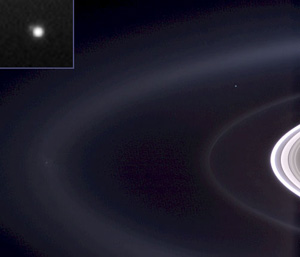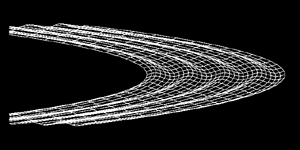
In this unique view, the Cassini orbiter observed Saturn while its cameras were hidden in the planet's shadow. Click on image for a larger view or download the full resolution view.
NASA/JPL/Space Science Institute
It's amazing what a change of perspective can do. Just ask astronomers working with NASA's Cassini spacecraft. On September 15th, the Saturn orbiter found itself in a rare position — deep within a Saturnian eclipse. For about 12 hours the craft observed the ringed world from within the planet's shadow. In the unique image at right, the Sun is directly behind Saturn and the rings shine in scattered, rather than reflected, light. From this point of view small particles in the rings appear especially bright, much the way that cobwebs look brighter when lit from behind.
Such a perspective reveals many new things. First off, the team uncovered two new rings made of tiny dust particles, and they confirmed the existence of a couple others. Second, rings and moons are intertwined. "When you see a ring, there is likely to be a satellite," says Joe Burns (Cornell University). Sure enough, one of the finds is associated with the moonlets Janus and Epimetheus, and a second overlies the orbit of a tiny moon called Pallene.

The spot at the top left is a zoomed-in view of our home. When Cassini shot this picture of Earth, the Atlantic Ocean and the western coast of north Africa were facing Saturn.
NASA/JPL/Space Science Institute
Two other new rings were spotted inside the dark, narrow Cassini Division, though the moonlets associated with them have thus far avoided detection. "Maybe they formed when a moon broke apart," says Burns, speculating on where the missing satellites might be.
The image also contains two tantalizing treats. Upon closer inspection one sees geysers spewing from the icy moon Enceladus. These cyrovolcanic eruptions supply the material of the E ring. And in the top-left corner of the view is a special little dot: Earth shining in the background.
In other ring news, Cassini scientist Matt Hedman (Cornell University) announced a facinating find concerning Saturn's D ring, the innermost. He determined the three-dimensional shape of the ring and found that it isn't flat like the rest. In fact it appears "vertically corrugated like a tin roof." The bands within it are spaced 30 kilometers apart. Hedman compared these findings to images taken from the Hubble Space Telescope in 1995, and found that 11 years ago, the same bands were spaced 60 kilometers apart.

This model shows to scale the structure of the waves in Saturn's D ring. The corrugated shape has bands that are currently 30 kilometers apart.
NASA/JPL/Space Science Institute
When he combined the rate at which the spacing is changing along with the vertical structure of the ring, Hedman came up with an amazing result: "We have evidence that the D ring was recently disrupted by impact. Perhaps a comet or meteorite passed through the ring system," he says. Calculating backward in time, in 1984 something plowed through the D ring and "gave it some angular momentum, lifting it out of the plane." According to Hedman's models, it only takes a body a few meters across to kick up enough dust to match what we see.
 0
0
Comments
You must be logged in to post a comment.